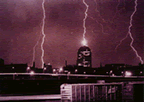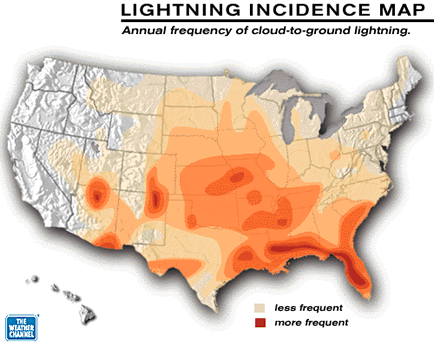Lightning
Local Weather via the National Weather Service
During any given minute, there are more than a thousand thunderstorms around the Earth causing some 6,000 flashes of lightning. Every minute!

Thunderstorms are caused by rapidly rising and falling currents of air. The friction from this moving air creates electrical charges within a cloud. Water droplets and ice pellets fall, carrying charged electrons to the lower portion of the cloud, where a negative charge builds. A positive charge builds up near the top of a cloud.
Most of the electrical energy in a thunderstorm is dissipated within the clouds, as lightning hops between the positively and negatively charged areas. Lightning becomes dangerous, though, when it reaches for the Earth.
How Lightning Strikes


When the negative charge in the cloud becomes great enough, it seeks an easy path to the positively charged ground below. The current looks for a good conductor of electricity, or a tall structure anchored to the ground (such as a tree or a tall building). The negative charge sends out a feeler, called a stepped leader, which is a series of invisible steps of negative charges.
As the stepped leader nears the ground, a positive streamer reaches up for it. Only then, once this channel is made, does the visible lightning happen. A return stroke runs from the ground to the clouds in a spectacular flash.
Though the bolt appears continuous, it is actually a series of short bursts. Most lightning strikes occur in less than a half second and the bolt is usually less than 2 inches in diameter.
Thunder

The air around a lightning bolt is superheated to about 54,000 degrees Fahrenheit (five times hotter than the sun!). This sudden heating causes the air to expand faster than the speed of sound, which compresses the air and forms a shock wave; we hear it as thunder. Since the bolt is actually several short bursts strung together, multiple shock waves are created at different altitudes; this is why thunder seems to rumble — each shock wave takes a different amount of time to reach your ear.
Estimating Distance

Because light travels faster than sound (186,291 miles per second vs. 1,088 feet per second) you see lightning before you hear the thunder. When you see it, count the seconds before the thunder arrives. Divide this number by 5, and you'll know approximately how many miles away the lightning was (5 seconds = 1 mile).
Lightning Facts
- A lightning charge contains 30 million volts at 100,000 amperes.
- The total energy in a large thunderstorm is more than that in an atomic bomb.
- About a hundred U.S. residents are killed by lightning every year.
- Benjamin Franklin's famous kite experiment, in 1752, showed that lightning was electricity.
- The Empire State Building in New York City is struck by lightning about 25 times every year.

Although cloud-to-ground lightning strikes pose the most danger to people on the ground, they make up only about 20% of all lightning strikes. The most common type of lightning in a thunderstorm is in-cloud lightning, which occurs within the cloud itself.
Cloud-to-cloud lightning is a common occurrence in which opposite electrical charges in one cloud attract those in another.
An extremely rare form of lightning is called ball lightning. It is so rare that scientists often question its existence. Those who have witnessed ball lightning describe it as a round ball of fire seen on telephone wires or entering through windows and doors during a thunderstorm.
Then there's heat lightning. Heat lightning has nothing to do with how warm temperatures are on a summer's night. It is actually lightning seen from a distant thunderstorm too far away for the thunder to be heard.
A Warning is Issued
You observe and/or hear lightning and thunder, or thunderstorms are in the forecast.
A severe thunderstorm warning is in effect — what should you do?
At Home
If you are at home, protect yourself and your family following the safety tips below:
- Follow weather reports. Make sure a battery-powered radio is nearby.
- Do not turn on the television. Listen to National Oceanic and Atmospheric Administration (NOAA) Weather Radio for the most current information.
- Lightning can cause power surges. Unplug all appliances before the storm hits.
- Avoid using the phone. Telephone lines can conduct electricity.
- Metal pipes also conduct electricity. Stay away from faucets, sinks, and bathtubs.
- Close the blinds and shades of your window, then keep away from them.
- Keep pets on a leash or in a carrier.
Away From Home
There are times when storms come up suddenly. If you are away from home, protect yourself and your family by taking cover in the best shelter you can find.
- If you are in or near the water, go to land immediately and find shelter.
- If choosing between a building or a car, choose the building.
- If choosing between a hard-top and a convertible, choose the hard-top.
- If you're in a car, keep the windows closed.
- If there is no shelter, find a low-lying, open place that is a safe distance from trees, poles, or metal objects that can conduct electricity. Make sure it is not likely to flood.
- Assume a tucked position: Squat low to the ground. Place your hands on your knees with your head tucked between them. Try to touch as little of your body to the ground as possible.
- Do not lie flat on the ground, as your fully-extended body will provide a larger surface to conduct electricity. Stay in a tuck position well after the storm passes.
- Watch for local flooding — you may have to move if water begins to accumulate.
- If you feel your hair stand on end in a storm, drop into the tuck position immediately. This sensation means electric charges are already rushing up your body from the ground toward an electrically charged cloud. Minimize your contact with the ground to minimize your injury.
